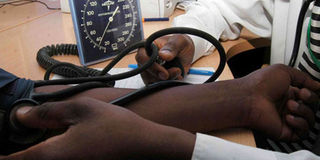Why you should have blood pressure checked

A nurse at Karen Hospital in Nyeri measures a patient's blood pressure on October 15, 2010. High blood pressure is a risk factor for future diseases like heart attacks, stroke, kidney failure and early death. PHOTO | JOSEPH KANYI | NATION MEDIA GROUP
What you need to know:
- High blood pressure is very common and left untreated, it can lead to heart attack.
- Lifestyle changes are the cornerstone of hypertension prevention and treatment.
We are barely two weeks into the May Measurement Month that is dedicated worldwide to increasing awareness of hypertension (high blood pressure) and what a better opportunity to reflect on this silent killer of millions.
This year, the target is to screen at least 25 million people aged above 18 years who have not had their blood pressure measured in the last year.
High blood pressure is very common and left untreated, it can lead to heart attack, stroke, kidney failure and even death.
It is estimated that one in four Kenyans above 18 years is hypertensive and above 50 years, it is one in two persons.
PREVENTABLE
And more than half of Kenyans have never had their blood pressure measured, according to a 2015 National Stepwise Survey.
Of those not aware about their blood pressure status, 70 per cent are men.
But here’s the thing: you don’t have to die from hypertension. It is preventable and treatable.
First, high blood pressure is not a disease. It is a risk factor for future diseases like heart attacks, stroke, kidney failure and early death.
LIFESTYLE CHANGES
What this means is that my life, brain, heart, kidney and blood vessels are safe every time I visit a clinic and my blood pressure is measured.
In addition to blood pressure, one should check blood sugar, cholesterol and body mass index.
Secondly, lifestyle changes are the cornerstone of hypertension prevention and treatment.
To quote the World Health Organization, up to 80 per cent of heart diseases and Type 2 diabetes and 40 per cent of cancers could be prevented with improved dietary choices and adequate physical activity levels.
The lifestyle measures for hypertension include salt restriction, high consumption of vegetables and fruits, increased intake of fish and reduced content of saturated fat in diet.
EXERCISE
In addition, one should maintain appropriate weight, exercise regularly, consume alcohol moderately and quit smoking.
We know from studies that more than five million Kenyans consume some form of tobacco.
Weight management is crucial even as cases of obesity and being overweight in men and women increase worldwide.
A high body mass index in men has been shown to be a strong risk factor for hypertension.
Daily exercise is also key. Many people hardly move during their working day and even during leisure time.
The goal is 30 minutes of decent physical exercise every day.
This could be brisk walking, jogging, swimming, or cycling and should be combined with muscle training.
HEALTHY DIET
Studies looking at effect of potassium intake on blood pressure have shown benefits.
The highest intake of more than 4700 mg/day was associated with the largest systolic blood pressure reduction.
Highest potassium concentrations are found in figs, molasses, seaweed, dates, prunes, tree nuts, avocados, bran cereal, wheat germ, bananas and lima beans.
Just a quarter of a teaspoon of Morton salt substitute provides more potassium than such frequently cited food sources as bananas, oranges, potatoes, and spinach.
Third, the drugs for treating established hypertension are mostly generic and fairly inexpensive.
Unfortunately, studies in many countries indicate that blood pressure goals are achieved in only 25 to 40 per cent of the patients who take antihypertensive drug treatment.
ACCURATE MEASUREMENT
In Kenya, more than 90 per cent of those undergoing treatment for hypertension have not attained control of the condition.
The bottom line is that how blood pressure is measured, where it is measured and the time counts.
A common mistake I have observed in many clinics is when a person walks in and a blood pressure cuff is strapped on the arm straightaway.
This can give misleading results.
Instead, the person should be asked to sit in a chair with their back upright in a quiet room for at least five minutes.
Several blood pressures should be taken and an average of three measurements per visit recorded. Relying on one measurement can be misleading.
Subiri Obwogo is a medical doctor and public health practitioner.





